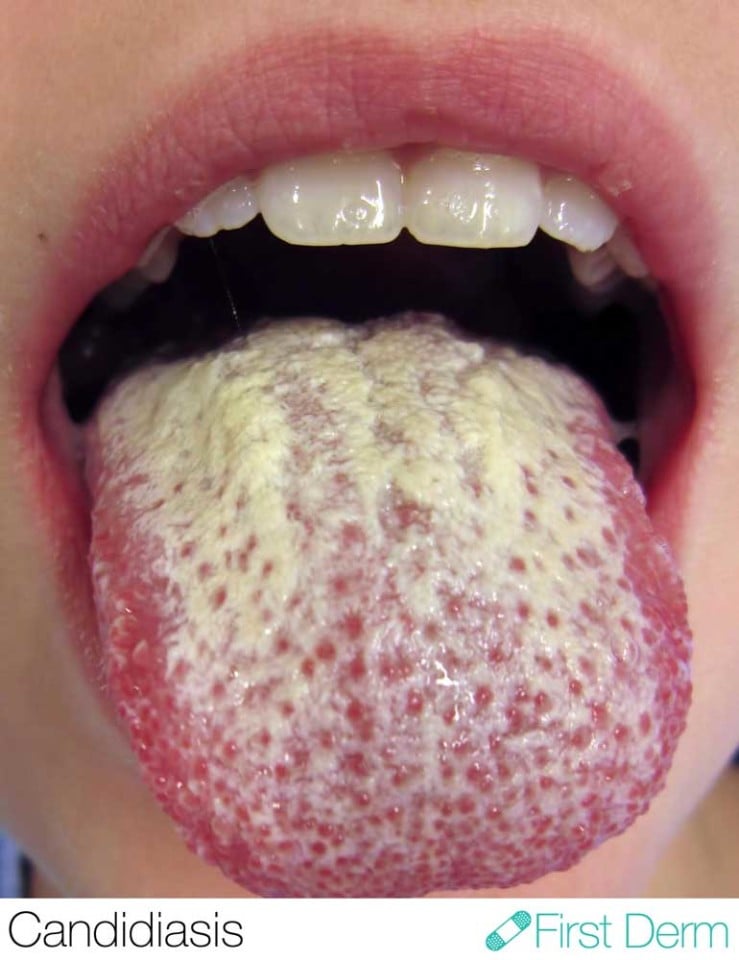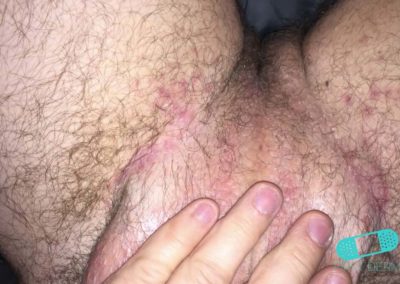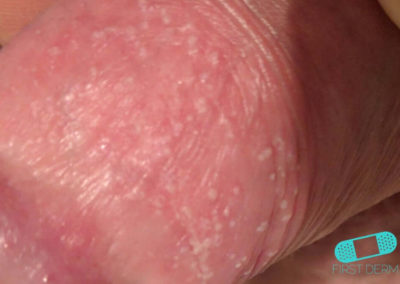Candidiasis (Cutaneous Candidiasis)
Medically reviewed by The Dermatologists and written by Dr. Alexander Börve
More than 5 million US cases per year
- Often self-diagnosable
- Symptoms: Creamy white patches, vaginal itching
- Color: Typically white
- Location: Around the mouth or genitals
- Treatment: Antifungal creams or mouthwash
ICD-9: 682.9
Candidiasis is a general term for fungal infections marked by redness and itching around the mouth or genitals. Oral candidiasis, called thrush, involves white spots on the mouth and tongue, sore throat, and difficulty swallowing. Candidiasis in the female genitals is called a yeast infection. Oral candidiasis (thrush) is most common in infants, the elderly and those with a weakened immune system.
There are over 20 species of Candida yeasts that can cause infection in humans. The most common type is Candida albicans. 90% of people with HIV/AIDS develop Candida infections.
Try our FREE dermatology search engine and get peace of mind within a second
Symptoms
Symptoms of candidiasis are varied, but most include redness, rashes, blisters and itching of the affected area. This is most commonly found in between fingers and toes, and under the breasts. Such infection in the genital area with the association is associated with vaginitis and balanitis.
Vaginal itching and irritation with a white discharge resembling cottage cheese are indicators of vaginal yeast infection.
Oral candidiasis is marked by white spots in the mouth and on the tongue. These spots form cream white patches. Painful cracks at the corners of the mouth is almost a common symptom for thrush. This can cause difficulty swallowing and redness.
What can I do?
Some studies suggest that reducing sugar in the diet may help prevent yeast infections.
It may also help to reduce consumption of substances with high concentrations of yeast, such as alcohol, fruits, potatoes and pork, to name a few. Some people choose to go on the “Candida diet” to prevent candidiasis. However, it is not clear whether the diet actually gets rid of Candida or helps people feel better because it is a healthful diet.
In one study, a combination of bee-honey and yogurt has a high cure rate for candida among pregnant women.
Try our FREE dermatology search engine and get peace of mind within a second
Should I seek medical care?
Candidiasis on the skin is not life-threatening, but you should seek medical advice if the over-the-counter medications do not improve the situation.
Treatment
Antifungal creams and suppositories can cure genital candidiasis, and antifungal mouthwash and pills can kill yeast in the mouth. Medications that are available over-the-counter include creams and suppositories, such as miconazole (Monistat), ticonazole (Vagistat), and clotrimazole (Gyne-Lotrimin).
Image Source: Human tongue infected with oral candidiasis. From: Wikipedia Commons. By: James Heilman, MD. CC-BY-SA 3.0. Watermarked from original.
Source:
Centers for Disease Control and Prevention. Candidiasis. Available at: https://www.cdc.gov/fungal/diseases/candidiasis/
University of Maryland Medical Center. Candidiasis. Available at: http://umm.edu/health/medical/altmed/condition/candidiasis
Abdelmonem AM, Rasheed SM, Mohamed A Sh. Bee-honey and yogurt: a novel mixture for treating patients with vulvovaginal candidiasis during pregnancy. Arch Gynecol Obstet. 2012;286(1):109-14.
Merck Manual. Candidiasis. Available at: https://www.merckmanuals.com/home/infections/fungal-infections/candidiasis
Ask a Dermatologist
Anonymous, fast and secure!

The Specialist doctor from the University Hospital in Gothenburg, alumnus UC Berkeley. My doctoral dissertation is about Digital Health and I have published 5 scientific articles in teledermatology and artificial intelligence and others.
![Candidiasis (Cutaneous Candidiasis) (03) skin [ICD-10 L02.91]](https://www.firstderm.com/wp-content/uploads/2016/03/Candidiasis-Cutaneous-Candidiasis-03-skin-ICD-10-L02.91-2-400x284.jpg)

![Candidiasis (Cutaneous Candidiasis) (21) pubis [ICD-10 L02.91]](https://www.firstderm.com/wp-content/uploads/2016/03/Candidiasis-Cutaneous-Candidiasis-21-pubis-ICD-10-L02.91-2-400x284.jpg)



